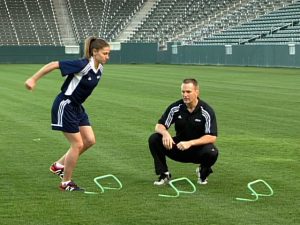Vertical and horizontal asymmetries are related to slower sprinting and jumping performance in elite youth female soccer players by C. Bishop., P. Read., J. McCubbine., & A. Turner in the Journal of Strength & Conditioning Research.
Abstract:
Background:
Inter limb asymmetries refer to the function of one limb in respect to the other. Given the multi planar nature of soccer, establishing between limb differences from multiple jump tests is warranted (1). Previous research has adopted many methods to highlight asymmetry prevalence through isokinetic dynamometry (2), isometric squat & mid-thigh pull (3), back squatting (4), and a variety of jumping based tasks (5). For practitioners though, prevalence alone provides limited information, so determining whether inter limb asymmetries have a detrimental impact on physical performance in respect to your athletic population is vital. By doing so, this allows a targeted intervention to take place if deemed true asymmetries, or test variability.
Objective:
The primary study aim was to assess the relationship between jumping asymmetries and sprint and jump performance in elite youth soccer players. A secondary aim was to quantify inter limb asymmetries from multiple unilateral jump tests in order to provide an asymmetry profile.
Methods:
19 elite youth female soccer players were recruited from a Tier 1 regional training centre of a professional soccer club. The players trained at least 36 weeks of the year and were required to complete a minimum of 2×30 minute structured strength and conditioning sessions per week. The subjects were tested in Single Leg Countermovement Jump (SLCMJ), Single Leg hop for distance, Triple hop for distance, Crossover hop for distance and 5, 10 & 20 metre sprint times.
Results:
SLCMJ showed greater side-to-side differences compared to all other jump tests. The results seen indicate that larger vertical asymmetries, seen in SLCMJ, were associated with slower sprint times. Asymmetries during the triple hop test were associated with reduced horizontal jump performance, whilst vertical asymmetries were associated with reduced vertical jump performance.
Conclusion:
Results suggest that asymmetry is task dependent as the SLCMJ produced significantly greater between limb differences compared to all horizontal jump tests. Significant relationships were found between asymmetries in SLCMJ and sprint times. SLCMJ may be the most appropriate jump test to identify the prevalence of inter limb asymmetries. A similar trend was seen in Lockie et al. (2014), whose population consisted of adult male team sport athletes. Notably, both researchers stress the importance for coaches to be aware of true asymmetries, rather than test variability. This research highlights anything over 12% with Lockie et al. (2014), highlighting anything over 15% as asymmetrical. A difference like this would warrant a specific training intervention to counteract the issue. Although a definitive explanation as to why vertical jump assessments highlight greater asymmetries compared to horizontal is not available, the author suggests that kids practice single leg horizontal activities more which may explain the difference. With this in mind, this research follows the popular force vector theory seen in strength training. Unilateral jump performance is direction specific (1), and it appears now so are asymmetries.
Practical Applications:
Jump assessments are easy to administer and ecologically valid. The SLCMJ is the most appropriate for identifying inter limb asymmetries in elite youth female soccer players and these differences are associated with slower sprint times. As practitioners, it is important to determine which assessments are important for your specific adult population, and what determines asymmetry as opposed to test variability.
References:
- Bishop, C., Read, P., McCubbine, J., & Turner, A. (2018). Vertical and horizontal asymmetries are related to slower sprinting and jumping performance in elite youth female soccer players. Journal of Strength and Conditioning Research.
- Costa Silva, J. R., Detanico, D., Dal Pupo, J., & De la Rocha Freitas, C. (2015). Bilateral asymmetry of knee and ankle isokinetic torque in soccer players u20 category. Brazilian Journal of Kinathropometry and Human Performance, 17, 195-204.
- Hart, N. H., Nimphius, S., Cochrane, J. L., & Newton, R. U. (2012). Reliability and validity of unilateral and bilateral isometric strength measures using a customised, portable apparatus. Journal of Australian Strength & Conditioning, 61-67.
- Newton, R. U., Gerber, A., Nimphius, S., Shim, J. K., Doan, B. K., Robertson, M., Pearson, D.R., Craig, B.W., Hakkinen, K., Kraemer, J. (2006). Determination of functional strength imbalance of the lower extremities. Journal of Strength and Conditioning Research, 20, 971-977.
- Meylan, C., McMaster, T., Cronin, J., Mohammed, N., Rogers, C., & Deklerk, M. (2009). Single-leg lateral, horizontal, and vertical jump assessment: reliability, interrelationships, and ability to predict sprint and change-of-direction performance. Journal of Strength and Conditioning Research, 23, 1140-1147.
- Lockie, R. G., Callaghan , S. J., Berry, S. P., Cooke, E. R., Jordan, C. A., Luczo, T. M., & Jeffriess, M. D. (2014). Relationship between unilateral jumping ability asymmetry on multidirectional speed in team sport athletes. Journal of Strength and Conditioning Research, 28, 3557-3566.

